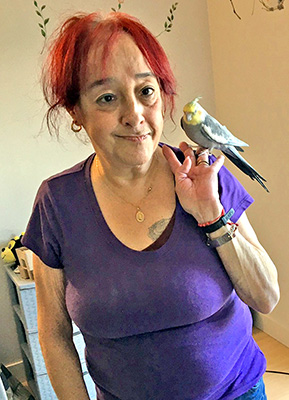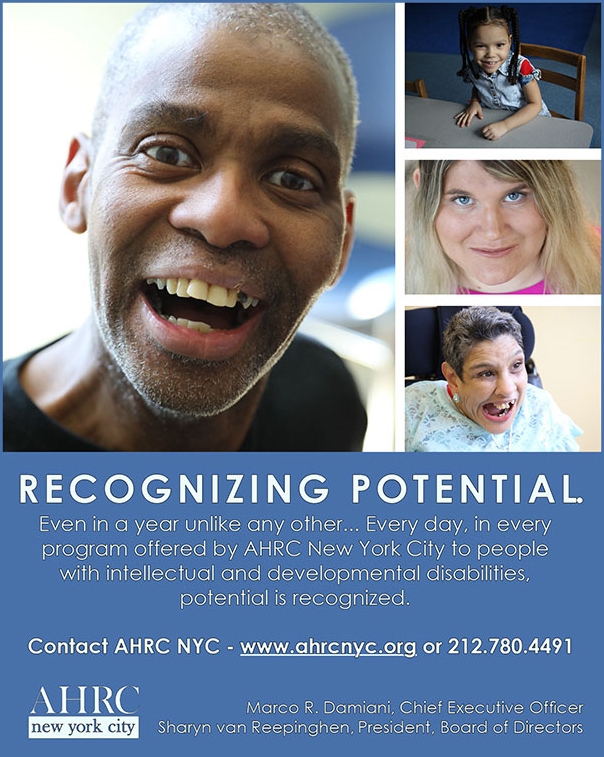When AHRC New York City asked different departments to identify perspective tenants with intellectual and other developmental disabilities (I/DD) for 12 new Bronx apartments, it was uncertain about what to expect.

Walter Glasco enjoys the view from the communal outdoor space from Parkside Terrace in the Bronx
But what is abundantly clear after two years is that a partnership among AHRC NYC, the state of New York, and a developer to create affordable housing in the Bronx for people with I/DD has evolved into much more than a home.
“They all know each other, have each other’s phone numbers and hang out…all without staff intervention,” said Jennifer Teich, AHRC NYC’s Associate Vice President, Individualized Supports. “I didn’t expect them to gel organically the way they did.”
Three ladies attend a yoga class most mornings at a studio around the corner. Three others go to church together. “The support they give each other has made them safer and happier,” Teich said.
Then came COVID-19, coinciding with the one-year anniversary of living independently, a goal all the residents identified prior to moving in.
A Major Milestone Amid the Pandemic
The tenants marked their second anniversary at Parkside Terrace in March. Unlike the first year, there were new rituals to practice: Wash your hands as soon as you come in the house, morning temperature checks and masks, said Jennifer Jimenez, AHRC NYC Residential Habilitation Counselor.
Being home and watching the news also posed some problems. Anxiety increased and one tenant decided to self-quarantine because she didn’t want to risk catching the virus. Jimenez took on the role of a mother – repeating herself constantly and reminding people to wear their mask anytime they left their apartment. “We had to be on top of them so they understood how serious it was,” Jimenez said.
To support the tenant, who self-quarantined, Jimenez and Blanca Ortiz, Home Care Field Supervisor, explained to her that everyone needs to adjust.
“If you quarantine too long, it will be difficult for you to get used to the new normal,” Jimenez said, recalling the conversation. “You need to dip your toe into it.” The conversation helped.
The tenants, who already had formed strong friendships, would gather in the staff office off the building’s main entrance. The office, which resembles a living room, became a gathering place to catch up with one another or seek assistance.
A Place to Call Home
For Walter Glasco, moving into Parkside Terrace ended his bout with homelessness. Through AHRC NYC’s employment program, Glasco secured a job at the Staten Island Ferry in 2007. At times, he was so cash strapped he could not afford mass transit. So, he walked nearly six miles to the West Side ferry terminal from a 33rd Street shelter on the far East Side. While sleeping in a train station, co-workers told him it wasn’t safe to do that. “I didn’t want to go back to the shelter, but I didn’t have a choice,” Glasco recalled. After my last stay in the shelter system, my Care Manager told me ‘I’m going to get you in a good home, your own home.’ I was overjoyed when I found out I got selected.”
Glasco moved into his studio apartment at Parkside Terrace on March 24, 2019. “The neighbors are nice and I have a sense of privacy,” he said. With AHRC NYC’s support, Glasco is thriving in his home. “It means a lot to have my own space now,” he said. “I’m learning something new every day.”
Creative Thinking Reunites Tenant with Birds
Jimenez began working with Nora Katz two weeks after she had moved into the building. Katz, 65, had lived at AHRC NYC’s Fordham Oval Plaza in the Bronx for more than 25 years and was ready to move to her own apartment.
Parkside, however, had a no pet rule, forcing Katz to part with her three beloved birds – Cuchi (a cockatiel) and Tom and Mary (parakeets.) “She was so heartbroken without her birds,” Jimenez said. Her aunt began looking after them.

Nora Katz with one of her support birds
enjoys living on her own
Jimenez started researching an idea. Within two weeks, she submitted documentation to certify Cuchi, Tom and Mary as support birds. Katz is thrilled to have them living with her again.
“They make me happy and are good company,” she said. “They give me support.”
“This is what makes me happy. I love helping people,” Jimenez said. “When someone is hurting, it hurts me too. She really, really missed them.”
Mary, however, recently died. In her typical fashion, Jimenez suggested they consult a nearby pet shop about finding a new partner for Tom. “That made her feel a little better,” Jimenez said.
Exceeding Expectations
Elizabeth Aguiar, Manager of AHRC NYC’s Fordham Oval Plaza, is thrilled to see the three former tenants – Nora, Christie Cuttito, and Carmen Rodriguez – doing so well. “Nora is doing great,” Elizabeth said. “She calls us on a daily basis to let us know how she’s doing or to ask questions. We’re very proud of them and happy to know that they’re able to do more than we expected.”
“This is precisely why we as a field need to raise expectations of the people we support,” said Marco Damiani, CEO, of AHRC NYC. “Only then will society erase the stigma surrounding people with disabilities and begin to see their abilities.”
“I always imagined I’d live on my own,” Katz said. “They said I wouldn’t be ready, but I was. I can do what I want in my own apartment.”
“Preparing Them for the World”
Catherine Nunez, Assistant Manager, recalled Rodriguez and Cuttito doing their own packing. “But Nora was living here for so long, I had to help her pick what she could take and pack her belongings,” said Nunez, who took on additional responsibilities when Aguiar was out on medical leave. “I helped them pick their furniture and set it up. It was a lot of back-and-forth.”
The women looked forward to being out in the community. “We were preparing them for the world,” Nunez said. “They would have to be more responsible for money management. It was a challenge, but we did it and the outcome was great.”
Beth Ann Silvestri, AHRC NYC Residential Coordinator, agreed. “I knew the women would not fail, but I didn’t know their lives would be enriched so much with friendships, collaboration in community and general happiness,” she said. “Shortly after moving in, I asked Carmen how she was doing. She just smiled and dangled her keys.”
An Unfamiliar Process
The process was not easy. It challenged staff members across AHRC NYC to go outside of their comfort zones.
“A lot of times, unfortunately, we operate in our own little world and in our own little bubbles,” Silvestri said, adding that other than Teich, no one understood the complexities of applying for affordable housing. The one thing they learned was they had to identify great applicants for housing. “Everybody brought their expertise to the table,” Silvestri said.
“Never Doubt Yourself”
Chevonna Fabre is working on passing the written exam for her learner’s permit with help from Jimenez. She also has learned how to pay her bills electronically from a check-cashing office. Fabre’s advice to other individuals with I/DD: “Go forth; you won’t be disappointed. Never doubt yourself. You can do all things.”
Lynn Uhlfelder Berman does Public/Media Relations for AHRC New York City. Dylan Watton is the Communications Coordinator for AHRC New York City.





